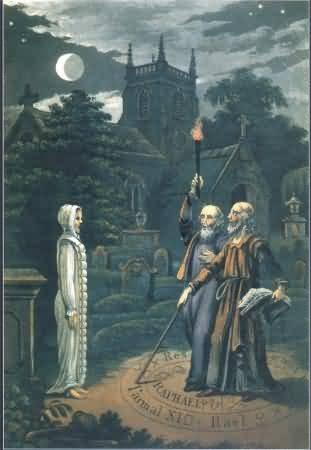Necromancy
1.)Necromancy is the act of conjuring the dead for divination. It dates back to Persia, Greece and Rome, and in the Middle Ages was widely practiced by magicians, sorcerers, and witches. It was condemned by the Catholic Church as "the agency of evil spirits," and in Elizabethan England was outlawed by the Witchcraft Act of 1604.
2.)Necromancy is not to be confused with conjuring devils or demons for help. Necromancy is the seeking of the spirits of the dead. The spirits are sought because they, being without physical bodies, are no longer limited by the earthly plane.
3.)Therefore, it is thought these spirits have access to information of the past and future which is not available to the living. It has been used to help find sunken or buried treasure, and whether or not a person was murdered or died from other causes. The practice of necromancy has been compared by some to modern mediumistic or practiced spiritualism. Many consider it a dangerous and repugnant practice. Dangerous because it is alleged that when some spirits take control of the medium they are reluctant to release their control for some time.
4.)Necromancy is not practiced in Neo-pagan Witchcraft, but it is practiced in Voodoo. There are two noted kinds of necromancy: the raising of the corpse itself, and the most common kind, the conjuring or summoning of the spirit of the corpse.
A.G.H. borrowed from...Mystica

The blackest of all the black arts is undoubtedly necromancy, the ancient method of communication with the dead. The art of raising the dead and controlling their spirits takes its name from Greek words meaning "dead" and "divination".
Necromancy can be divided into two main branches:
Divination by means of ghosts, and divination from corpses. The second method leads to the disinterment of corpses and rifling of graves for grisly charms which magicians and witches consider necessary for the effective performance of the magical arts.
Necromancy is a universal practice of great antiquity, only the profoundly initiated, brave and single-minded magician has any chance of success in such a venture, always considered to be extremely dangerous, for not only is a pact with the Devil necessary, but it is thought that the "astral corpse" has an intense desire to live again and could, by absorbing life-energy from living creatures, prolong its life idenfinitely, thus, unless he has taken adequate precautions, the magician might be in great danger.
To evoke the dead the magician needs to obtain the help of powerful spirits, both for his own protection and to compel the corpse or ghost to submit to his will. A spell from ancient Greece calls upon the powers of the mighty Kore, Persephone, Ereshkigal, Adonis, Hermes and Thoth, to bind the dead. According to a ritual described by Seneca, the Roman dramatist, the summoning of the dead involves not only a burnt sacrifice but a blood-drenched aItar.
Scent and odors must be carefully produced from burning substances for their powerful influences. Elaborate preparations include careful study of the positions of the planets, and especially of the moon and the influence of Saturn.
The site for the operation has to be chosen with care, the most favorable is some lonely crossroads, a vault, a ruin, an unfrequented forest, or a blasted heath.
Once a time is decided upon for the operation, a series of concentric circles of power must be drawn on the ground within which are inscribed crosses and other symbols, together with holy names of God. The circle must be blessed and consecrated, with the magician and his assistant standing at its centre, protected by the holy names from all danger. Then, wand in hand, the magician summons the dead to rise, using names of power.
Eliphas Levi and other magicians have suggested the need for some attempt at identification between the living and the dead, as for example the presence of a portrait, and a portion of bread which the ghost would be invited to consume. In his evocation, the magician summons the dead by name and, if he is successful, he has to face the frightening ordeal of a phantom screaming and gibbering with rage at having been compelled against its will to return to the realms of the living. Sometimes the dead appears in the shapes of furious beasts raging about the circle and threatening to tear the sorcerer to pieces.
When the dead finally decides to submit to the magician's will he often becomes transformed into a naked men who is willing to answer the questions put to him.
After the operation it is necessary to dismiss the dead, who usually vanishes amid clouds of sulphur. Under no circumstances the magician should leave the protection of the magic circle before this. He also has to remove all flowers from the place and after burning them, to bury the ashes deeply in the earth.
The whole operation is fraught with terrible dangers, for the slightest departure from the rites could involve the destruction of the operator and even inflict injuries upon his soul.
Borrowed from: http://www.satansheaven.com/necromancy.htm


